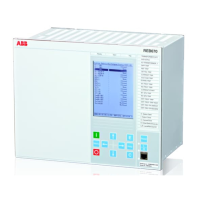• Normally open auxiliary contact
• “a” contact (that is, 52a)
•
“closed”
The second auxiliary contact indicates that primary device is open. In protection
literature it is called by different names as stated below:
• Normally closed auxiliary contact
• “b” contact (that is, 52b)
• “open”
Typically both contacts are used to provide position indication and supervision for
busbar protection.
SEMOD127523-18 v2
Minimum contact requirements
The minimum requirement for the busbar replica is the record of the disconnector
position by using just one auxiliary contact, either "normally open" or "normally
closed" type. However recording a pair of auxiliary contacts, representing the “open”
and “close” position, offer additional features which can improve the reliability of the
bus replica including supervision possibilities.
SEMOD127523-21 v3
Auxiliary contact evaluation logic
Two logic schemes can be found.
• Scheme1_RADSS "If not OPEN then CLOSED"
SEMOD127523-24 v3
As the name of the scheme suggests, only when the auxiliary contacts signal clean
open position ("normally open auxiliary (NO) contact input" = inactive and "normally
closed auxiliary (NC) contact input" = active), the disconnector is taken to be open. For
all other signal combinations the disconnector is considered to be closed. This scheme
does not pose any special requirements to the auxiliary contact timing. Only the
disconnector NC contact must open before the disconnector main contact is within
arcing distance. The time during which the POSOPEN and POSCLOSE signal inputs
disagree (that is, both binary inputs are active or both are inactive) is monitored by the
isolator supervision function. The maximum time allowed before an alarm is given can
be set according to the disconnector timing.
• Scheme2_INX "Closed or open if clear indication available otherwise
last position saved"
SEMOD127523-27 v4
As the name of the scheme suggests, only when the auxiliary contacts signal clean
“open” or clean “closed” position, disconnector is considered to be open respectively
closed. However this poses the stringent requirements on the auxiliary contacts that the
1MRK 505 370-UUS A Section 6
Differential protection
Busbar protection REB670 2.2 ANSI 117
Application manual

